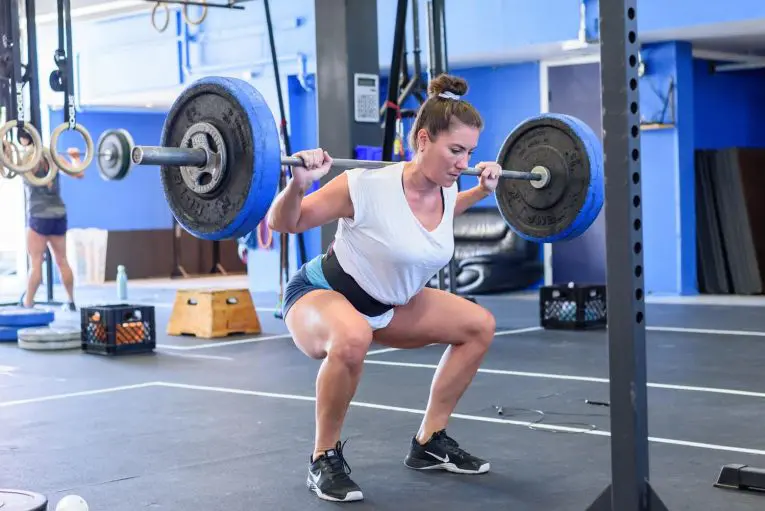Before we get into why tempo training is so valuable, it’s important to understand exactly how to read a tempo prescription, such as @3131 or @40×0.
And before that, you need to know the difference between the concentric and eccentric parts of any given movement.
Concentric-Eccentric Crash Course:
- The eccentric part of the movement is when the muscles are lengthening while producing force. This is sometimes referred to as the negative portion of the movement. During a squat, it’s when you’re lowering into the bottom of a squat, and during a pull-up, it’s when you’re lowering yourself back to the hanging position.
- The concentric aspect of the movement is the exact opposite: It’s when your muscles are contracting and shortening. This is when you’re prying yourself out from the bottom of a squat back to a stand, or when you’re pushing yourself off the ground on a push-up.
- The other two components of the movement are the top and the bottom, which are fairly self-explanatory. In a squat, the top is when you’re well, at the top, standing up, and the bottom is, of course, when you’re at the bottom of your squat.
To read tempo: The most important thing to remember is the first number in a tempo prescription refers to the eccentric piece of the movement. The second number refers to the bottom of the movement, the third number is the working part of the movement, or the concentric contraction, and the final number refers to the top of a movement. Basically, the numbers in the tempo flow in the same order you perform the movement.
Thus, let’s take four different tempos and consider a squat, a hinge, a push and a pull.
Read more: Eccentric Vs. Concentric Training.
Squat: @3131
- 3 = 3 seconds to lower into the bottom of the squat (eccentric)
- 1 = 1 second at the bottom of the squat
- 3 = 3 seconds to stand up (concentric) to the top of the squat
- 1 = 1 second at the top of the squat
Deadlift @4140
- 4 = 4 seconds to lower from the top of the deadlift back to the ground (eccentric)
- 1 = 1 second at the bottom of the deadlift
- 4 = 4 seconds to stand up with the bar (concentric) to the top of the deadlift
- 0 = 0 seconds at the top of the deadlift with the bar at your hips
Push-up @40×0
- 4 = 4 seconds to lower yourself from the top of a push-up to the ground (eccentric)
- 0 = 0 seconds rest at the bottom of the push-ups
- x = push yourself as fast and explosively as you can from the ground back to the top of the push-up
- 0 = 0 seconds rest at the top of the push-up
Pull-up @31×3
- 3 = 3 seconds to lower from the chin over the bar to the hang position (eccentric)
- 1 = 1 second at the bottom of the pull-up
- x = pull your chin over the bar as fast as you can
- 3 = 3 seconds to hold your chin over the bar
5 Reasons to include tempo training
1. More Body Awareness
Do you ever think you’re doing a movement correctly — you think you’re in a nice hollow body position, for example — but then you see yourself in a video and realize your spine is actually extended? Or you think your hip crease is below your knee at the bottom of your squat until a coach calls you out on your depth?
Level Up Your Fitness: Join our 💪 strong community in Fitness Volt Newsletter. Get daily inspiration, expert-backed workouts, nutrition tips, the latest in strength sports, and the support you need to reach your goals. Subscribe for free!
Body awareness, or motor control, is incredibly important for lifting, and there’s no better way to build this mind-body connection, than through tempo training.
Inexperienced lifters, in particular, can benefit from tempo training, as slowing down the movement helps us move more intentionally and essentially feel each part of the movement. This is required to become more in tune with where our body is in space — i.e. to develop motor control, and ultimately learn the technique correctly right from the start.
Similarly, tempo lifting also goes a long way in helping you fix any positional weaknesses, or muscular imbalances that you might have in any particular area of a movement.
2. More Targeted Strength
Tempo training basically asks you to spend more time in various portions of the movement, depending on the tempo prescription, which is a great way to build strength in each specific part of the lift.
This, of course, also makes isometric training and static holds, where you’re effectively holding a position, incredibly valuable for building strength. For example, a goblet squat with a 10 second isometric hold at the bottom of the squat is a great way to build strength and make you feel more comfortable at your end range of motion.
3. More Fat Burning
Tempo training is also useful for turning a strength session in a metabolic one.
Suddenly, your set of five squats has you spending 60 seconds under tension. Superset this with a set of tempo push-ups that also takes you 60 seconds, and suddenly you have a great strength-metabolic conditioning, fat-burning session.
4. Less Stagnation
For experienced lifters stuck in a plateau, adding a variety of new tempo prescriptions is a useful way to push through that stagnation.
Sometimes it even helps to get rid of percentages and focus purely on the rate of perceived exertion (RPE) under an aggressive tempo.
Focusing on your effort alone through RPE allows you to build more strength than you realize, and become less frustrated about your plateau because you’re consumed with poundage on the barbell. Then when you remove the tempo and return to your normal speed, all the grueling time under tension will provide a renewed sense of confidence, and likely newfound strength. Goodbye plateau!
5. More Recovery
Tempo work will force you to lift a little bit lighter, as the tempo will make the lift much more challenging. This puts less strain on your central nervous system, all the while providing the strength benefits that you would get from lifting a heavier load.
Less stress on your nervous systems means faster recovery, and this, of course, means higher quality training the next day. Compounded over time, this can have a significantly positive effect on long term health and performance.










